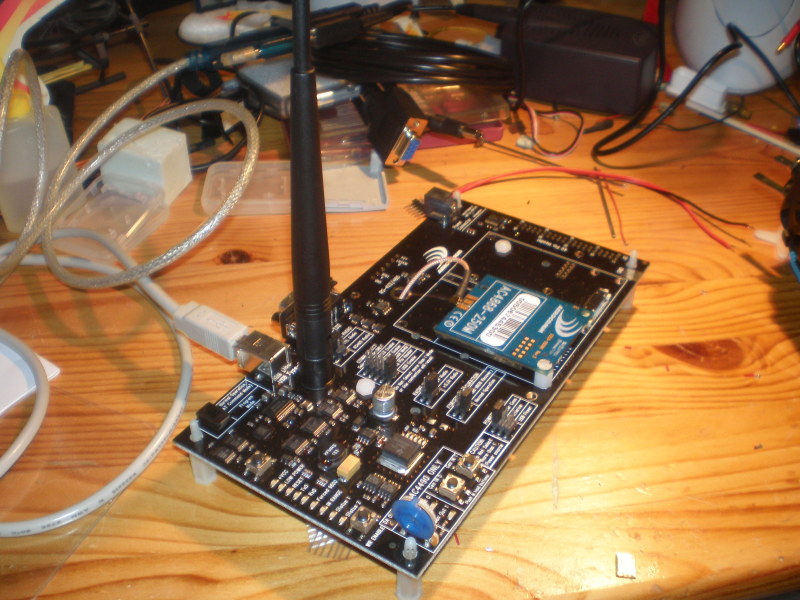User:SilaS
I am Szilard Fulop from Hungary, who is familiar with sw, linux, GNU and rc, but new on electronics.
I keep in the air some planes in the last one and half year, what was very interresting, but not enough :-) Now I want to expand my p-13 glider to be able to made photographs, videos and allow to made FPV flights assisted by autopilot controll and autonomus. This is a great 2,5m wingspan, 1.4kg weight electric glider, which is now under reconfiguration.
Completed:
- I complied and installed the paparazzi3 on Ubuntu/Dapper environment.
- Rebuilded my p-13 and achieved the first flying test with simulated weight.
- Captured the video system: CAM520 line, 1W 2.4GHz transmitter, diversity receiver with thwo 12dBI patch and a GD520 google. Now I am in building this together.
- Replaced the 420 with a 520 CCD, because the first delivered was failed.
- Rebuild 2nd time my p-13 after a crash during the first flight with FMA Copilot
- Tested the video system on fly! ;-) it was a dream!
- Tested the FS8CPI from FMA in an EPP plan. The sensors make great works, but the receiver is very weak in range!
- Buildup pan/tilt servos and test. Some EMI detected, but solved.
- Capture of assemled Tiny boards! :-)
- Retest of FS8CPI failed, replacement to a Futaba R168DF, which works well
- Replacement of video encoder AV100U to a Plextor Convertx TV402U
- Build up of my notebook and finishing the mobil base system
- With new 168DF I switched my RC signaling to PPM from PCM and now I am able to use the AeroPix gyro over FF9 training connector and hopefully will be able to catch PPM signals to Tiny...
- Achieved the first full imotion FPV flights with perfect video and full orinted piloting!
- Captured the final platform a Blizzard from Reichard! The wingspan is 3,5m...
- I switched on my tiny!
- I installed it on my old estarter http://silas.fornax.hu/album/flying/200710/tiny/
- The SDK-AC4868-250 FINALY is on my DESK!
- Calibration! almost done.
- Configuration of SDK-AC4868-250!!!
- Deal with IR sensor to produce a correct artifical horizon. DONE.
On going:
- I conducted the first AUTO2 flight!
- It still kill my throttle, because my batteries drop voltage too deep during motorized flight...
- Fly it in AUTO1, AUTO2 and if stable transfer it to p13
I You want to see my pages related to rc follow this link: http://silas.fornax.hu/album/flying
Some captured answers
Q: what are this time the most problematic things over the EMI? just in sentences.
A: - everything
- the GPS is sensitive to the distance and orientation of the video and modem antennas
- and the IR sensors, gyros, and wires to these sensors are sensitve to the video/modem emissions
- and of course the R/C is affected also - mostly from the modem
- the video sends a continuous wave at a very high frequency, but the modem sends "blocks" of data, so even though it is operating at high frequency, it is "turning on/off" at a much lower frequency, frequencies similar to R/C or analog sensors
Contribution
SDK-AC4868-250 ground modem part
How to use your modem inside the developer board over USB cable?
First of all, the standard cp2103 driver in the kernel does not known the Aerocomm Developer Board. Therefore You need to patch the kernel module and use it, if You want to use it in well designed developer board to avoid EMI.
I am using kernel 2.6.22-14.generic from package.
Download this cp2103-0.11.0.tar.gz.
Then use this patch:
--- cp2101.c 2006-09-06 21:36:31.000000000 +0200
+++ cp2101.c-working 2007-12-18 21:34:25.000000000 +0100
@@ -17,13 +17,14 @@
*
*/
-#include <linux/config.h>
+#include <linux/autoconf.h>
#include <linux/kernel.h>
#include <linux/errno.h>
#include <linux/slab.h>
#include <linux/tty.h>
#include <linux/tty_flip.h>
#include <linux/module.h>
+#include <linux/moduleparam.h>
#include <linux/usb.h>
#include <linux/version.h>
#include <asm/uaccess.h>
@@ -58,7 +59,7 @@
#endif /* LINUX26 */
-#include "usb-serial.h"
+#include "linux/usb/serial.h"
/*
* Version Information
@@ -86,6 +87,7 @@
static struct usb_device_id id_table [] = {
{ USB_DEVICE(0x10C4, 0xEA60) }, /* Silicon Labs factory default */
+ { USB_DEVICE(0x10C4, 0x81E7) }, /* Cygnal Integrated Products, Inc. Aerocomm developer board */
{ USB_DEVICE(0x10C4, 0x80CA) }, /* Degree Controls Inc */
{ USB_DEVICE(0x10AB, 0x10C5) }, /* Siemens MC60 Cable */
{ } /* Terminating Entry */
If You want to made it a bit more confortable, then made udev rules, like this 10-aerocomm.rules:
BUS=="usb", SYSFS{serial}=="14338", KERNEL=="ttyUSB*", SYMLINK+="cp2101", MODE="0666"
# mapping
BUS=="usb", SYSFS{idVendor}=="10c4", SYSFS{idProduct}=="81e7", KERNEL=="ttyUSB*", SYMLINK+="paparazzi/usb", GROUP="dialout"
It makes You after You plug the usb cable into your laptop a new /dev/paparazzi/usb link to the corresponding ttyUSB. You can use it at link definition and you can finaly forget to watching every time, where did it mapped time-to-time the device :-)
The achivement
Contact
Please contact me, if You are able to help to achieve this goals, or of course have any questions!
SilaS <silas"at"silas.hu>
